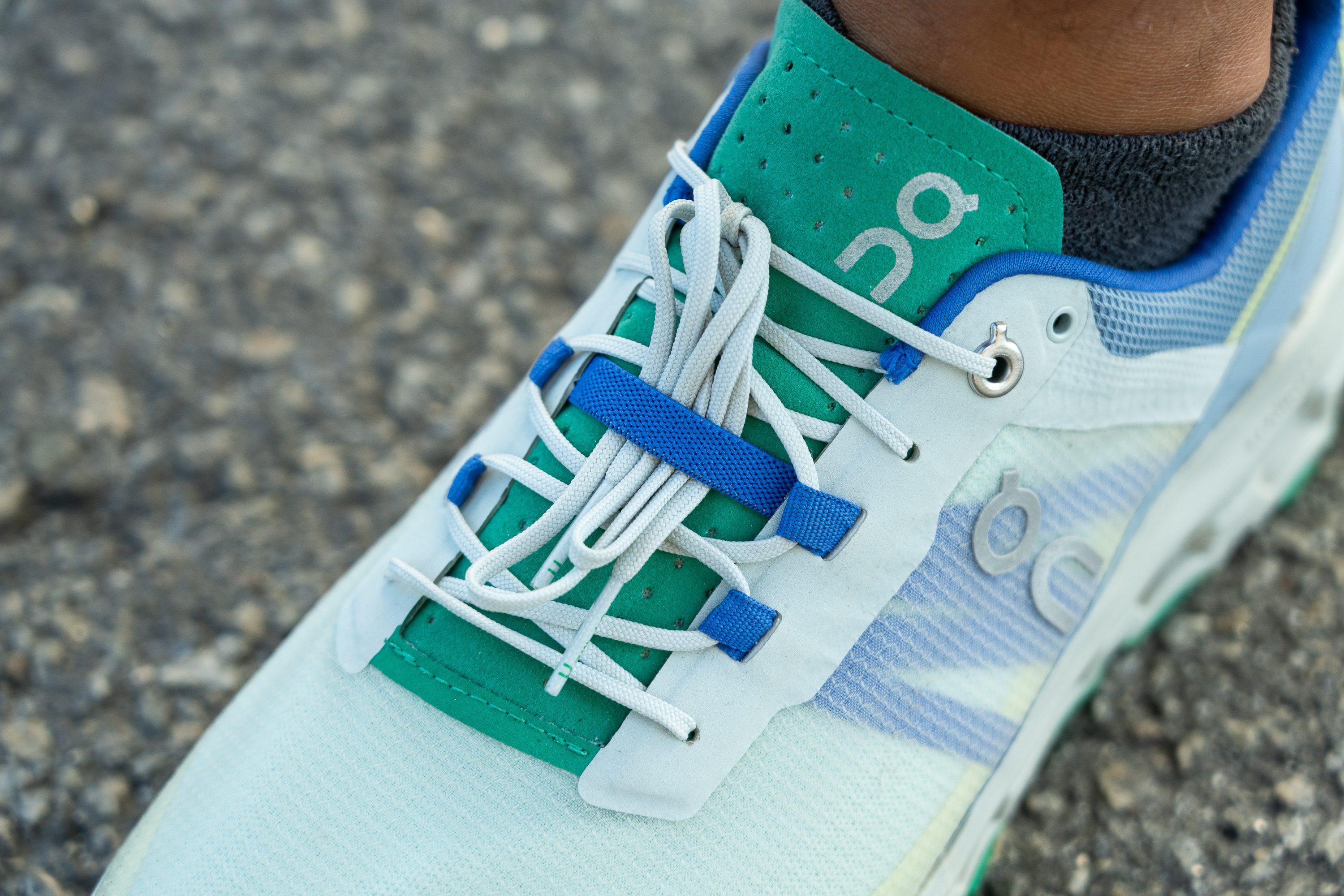Our verdict
- Top pick in best On running shoes (2023)
Pros
- Works great as a hybrid shoe
- Grippy and durable outsole
- Fun at high speeds
- Highly breathable
- Rockered for smooth heel-to-toe transitions.
- Secure lockdown
- No heel rub
- No Lace bite
- Environmentally friendly upper
- Suitable for walking or hiking
- Stylish for a trail shoe
Cons
- Not for technical trails
- Not a distance shoe
- Doesn’t accommodate wide feet
- Midsole catches debris
Audience verdict
- Top 18% in trail running shoes
- Top 24% in neutral running shoes
Comparison
The most similar running shoes compared
+ + Add a shoe | |||||
|---|---|---|---|---|---|
| Audience score | 89 Great! | 87 Great! | 89 Great! | 87 Great! | |
| Price | $150 | $130 | $180 | $150 | |
| Trail terrain | Light | Light | Light | Light | |
| Shock absorption | - | - | Moderate | Moderate | |
| Energy return | - | - | Moderate | Low | |
| Arch support | Neutral | Neutral | Neutral | Neutral | |
| Weight lab Weight brand | 10.1 oz / 285g 9.9 oz / 280g | 9.9 oz / 281g 9.9 oz / 280g | 10.4 oz / 296g 10.4 oz / 295g | 10.3 oz / 292g 10.9 oz / 309g | |
| Drop lab Drop brand | 10.3 mm 10.3 mm | 7.2 mm 6.0 mm | 10.2 mm 6.0 mm | 6.0 mm 5.0 mm | |
| Strike pattern | Heel | Mid/forefoot | Heel | Mid/forefoot | |
| Size | Half size small | True to size | True to size | True to size | |
| Midsole softness | Balanced | Soft | Firm | Balanced | |
| Difference in midsole softness in cold | Big | Small | Small | Small | |
| Plate | Rock plate | Rock plate | Rock plate | ✗ | |
| Toebox durability | Very bad | Decent | Bad | Decent | |
| Heel padding durability | Bad | Good | Decent | Bad | |
| Outsole durability | Good | Good | Good | Good | |
| Breathability | Breathable | Moderate | Breathable | Warm | |
| Width / fit | Medium | Medium | Medium | Narrow | |
| Toebox width | Medium | Medium | Medium | Medium | |
| Stiffness | Stiff | Stiff | Flexible | Moderate | |
| Torsional rigidity | Moderate | Stiff | Flexible | Stiff | |
| Heel counter stiffness | Flexible | Moderate | Flexible | Moderate | |
| Lug depth | 2.5 mm | 2.5 mm | 2.5 mm | 3.1 mm | |
| Heel stack lab Heel stack brand | 32.3 mm 32.3 mm | 31.0 mm 32.6 mm | 30.2 mm 27.0 mm | 31.7 mm 29.0 mm | |
| Forefoot lab Forefoot brand | 22.0 mm 22.0 mm | 23.8 mm 26.6 mm | 20.0 mm 21.0 mm | 25.7 mm 24.0 mm | |
| Widths available | Normal | Normal | Normal | NarrowNormal | |
| Season | SummerAll seasons | All seasons | SummerAll seasons | All seasons | |
| Removable insole | ✓ | ✓ | ✓ | ✓ | |
| Orthotic friendly | ✓ | ✓ | ✓ | ✓ | |
| Ranking | #150 Top 23% | #147 Top 40% | #105 Top 29% | #152 Top 41% | |
| Popularity | #469 Bottom 29% | #297 Bottom 20% | #258 Bottom 31% | #194 Bottom 48% |
Who should buy
We recommend the Cloudvista as an ideal choice for runners who:
- Want a road-to-trail shoe that is comfortable on asphalt as well as dirt
- Enjoy picking up the tempo from time to time
- Frequent well curated park trails
- Have a heel-striking gait
- Want a trail shoe that is stylish and suitable for walking, hiking, or day-to-day wear

Who should NOT buy
The Cloudvista’s subtle and short lug configuration makes it a less-than-ideal choice for tough and muddy terrains. The On CloudUltra 2 is an alternative that can better tackle technical trails without feeling too blocky on the road.
While the Cloudvista, like other On shoes, features a stiff speedboard embedded between the midsole and outsole; it does not serve as a rock-plate, leaving us vulnerable to jagged objects underfoot. For a more protective shoe that feels like a reinforced tank; we recommend the Brooks Cascadia 16, or the Hoka Tecton X 2 if its tectonic price tag doesn’t scare you off.
Ultra-runners look away as going the extra mile in the Cloudvista is a punishing and blister-inducing feat. Instead, take a look at the race-ready Hoka Speeedgoat 5 which speedily gobbles up long distances like a competitive eater.
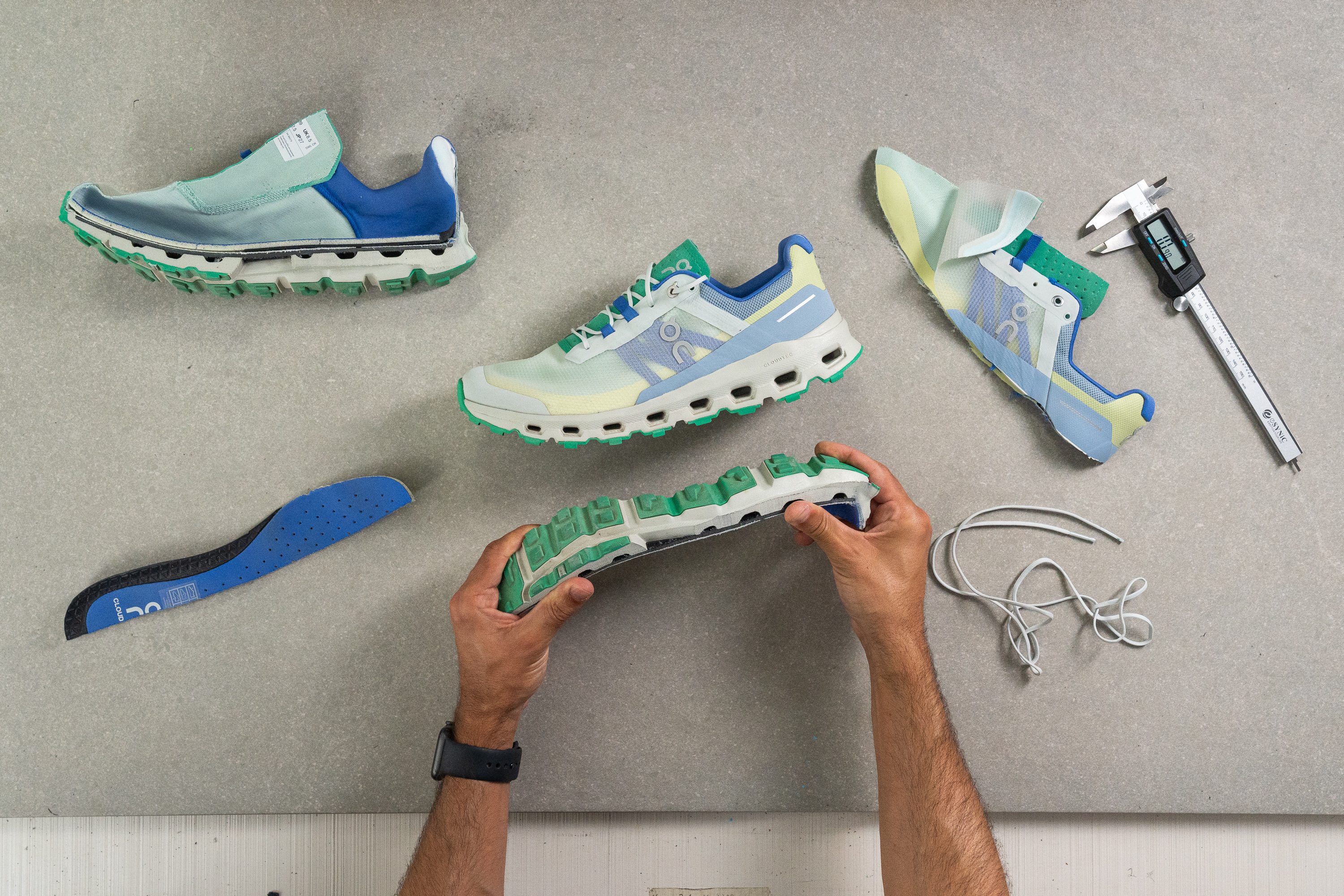
Cushioning
Heel stack
At 32.3 mm according to our caliper, there’s a healthy amount of foam at the heel of the Cloudvista which makes it slightly higher than our current lab average. This is a good stack height for heel-striking runners as it provides them with plenty of cushion to luxuriate in without being too tall and unstable.
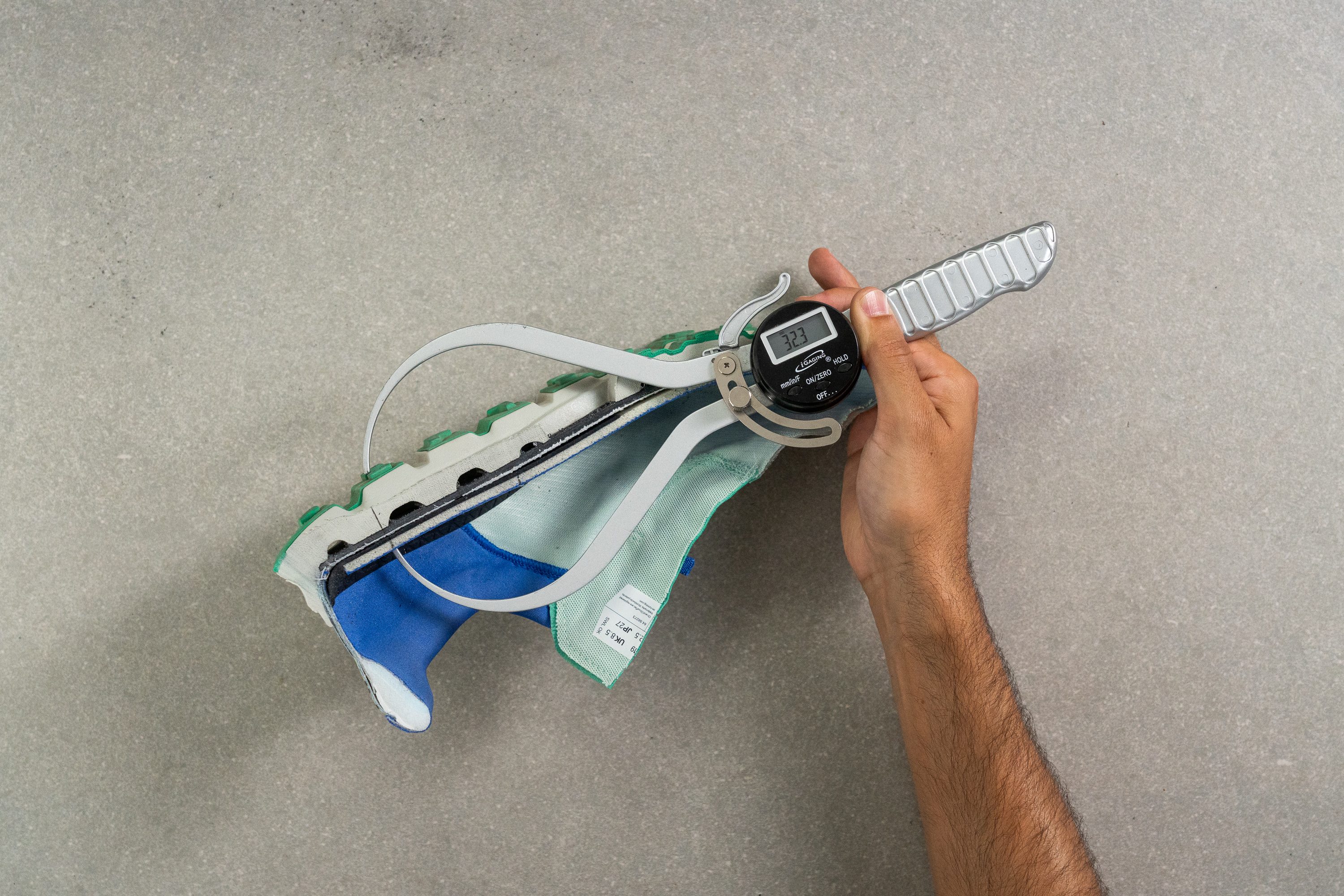
| Cloudvista | 32.3 mm |
| Average | 32.6 mm |
Forefoot stack
We measured the stack to be 22 mm at the forefoot, just a few millimeters shy of our current lab average. This still gives forefoot strikers enough impact protection on landings but, due to having less foam underfoot, the shoe will feel firmer than for their heel-striking counterparts.
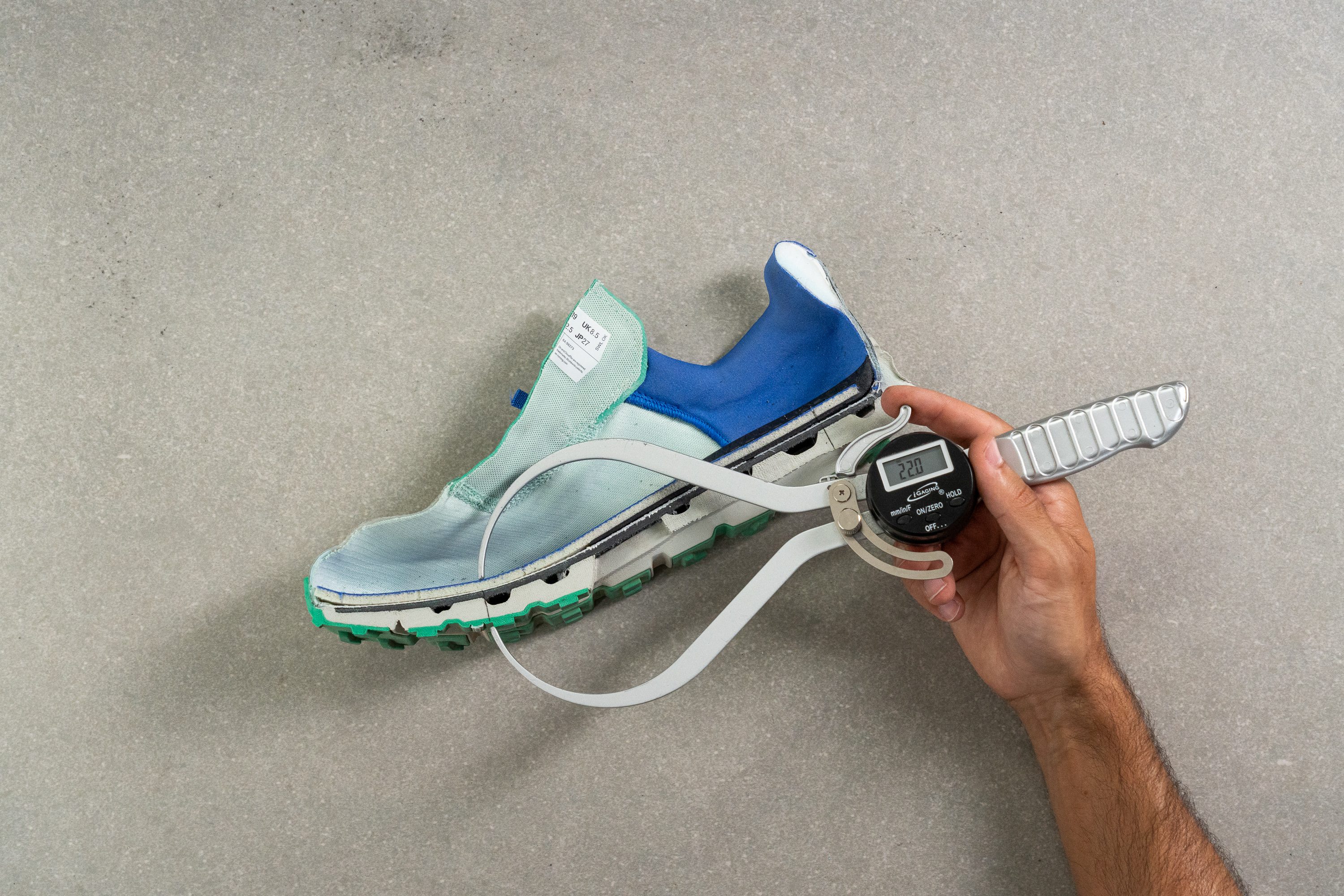
| Cloudvista | 22.0 mm |
| Average | 25.1 mm |
Drop
According to our stack measurements the Cloudvista has a heel drop of 10.6 mm. This is a little higher than the 9 mm officially stated by On, but still classifies the Cloudvista as a high-drop shoe.
This drop height definitely favors heel-strikers as it promotes the forward rolling of the foot, and can provide some protection against injuries like plantar fasciitis or Achilles tendinopathy.
Trail shoes usually have low (up to 4 mm) to medium (up to 8 mm) drops as steeper shoes have a tendency to feel unstable on uneven surfaces.
For trail shoes with more traditional drop heights in a similar price bracket, we suggest the Salomon Ultraglide 2 or the hybrid Nike React Pegasus Trail 4.
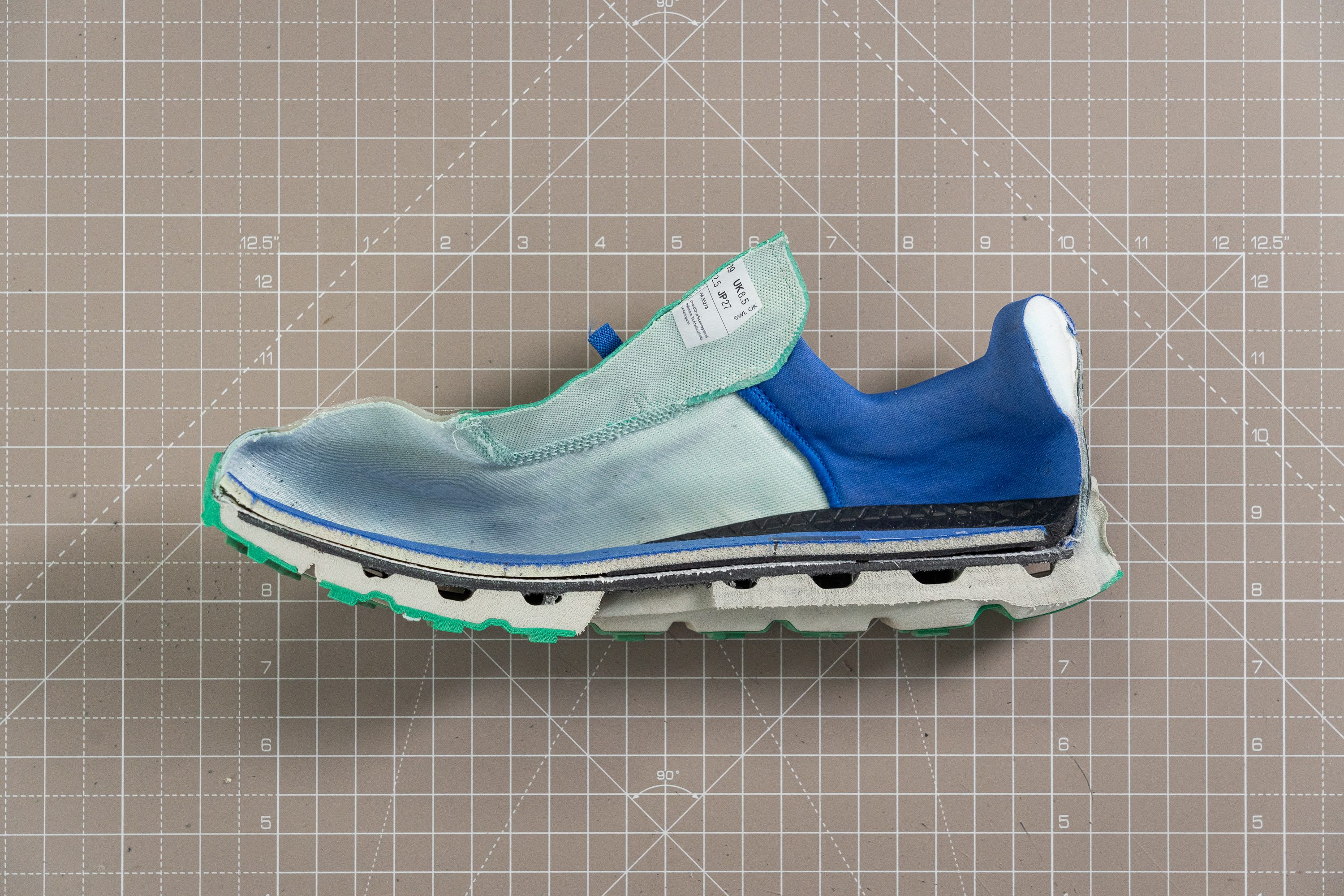
| Cloudvista | 10.3 mm |
| Average | 7.5 mm |
Midsole softness
We pressed our durometer against the Cloudvista’s midsole foam to see how soft it is. With a reading 23.5 HA, the Cloudvista is softer than our current lab average but doesn’t fall into the plush category. Instead the cushioning is balanced; with enough impact dampening for our landings and a good amount of energy return that gives the shoe a lively sensation underfoot.

The individual “clouds” in the midsole also play an important part in the shoe’s perceived softness. The smaller clouds at the forefoot don’t compress very much and return to shape quickly, lending the shoe a snappy toe off. Meanwhile, the larger ones at the back compress much more dramatically which increases the perceived cushioning at the heel.
This combined with the Cloudvista’s effective rockered geometry made our heel-to-toe transitions feel super smooth on our test runs. It also means that heel-strikers will reap the most benefit out of this shoe. For forefoot-strikers, we recommend looking at the New Balance Fresh Foam X Hierro v7 as an alternative with more forgiving cushioning at the forefoot.
| Cloudvista | 23.5 HA |
| Average | 21.9 HA |
Size and fit
Size
On Cloudvista fits half size small (182 votes).
Consider sizing up
Width / Fit
Measuring 98.8 mm at its widest point, the Cloudvista’s toebox falls within the average range for trail shoes. This should accommodate most runners except those with very wide feet, who will likely experience rubbing or blisters against the shoe’s inflexible upper material.
We advise wide-footed runners to check out the New Balance Fresh Foam X Hierro v7 or the Nike Terra Kiger 9 as more accommodating options.

This test follows an older methodology, which is why you don't see recently tested shoes in the chart. Results from different methodologies can not be compared.
| Cloudvista | 98.8 mm |
| Average | 98.9 mm |
Toebox width
Moving down to the area around the big toe, we measured the toebox to be 79.2 mm. This is ever-so slightly wider than our current lab average, but still not roomy enough for wide-footed runners for whom we recommend going ½ a size up if possible.

This test follows an older methodology, which is why you don't see recently tested shoes in the chart. Results from different methodologies can not be compared.
| Cloudvista | 79.2 mm |
| Average | 79.3 mm |
Traction / Grip
The rubber on the Cloudvista’s outsole is certainly grippy and gave us good traction on the road and on certain less technical trails.
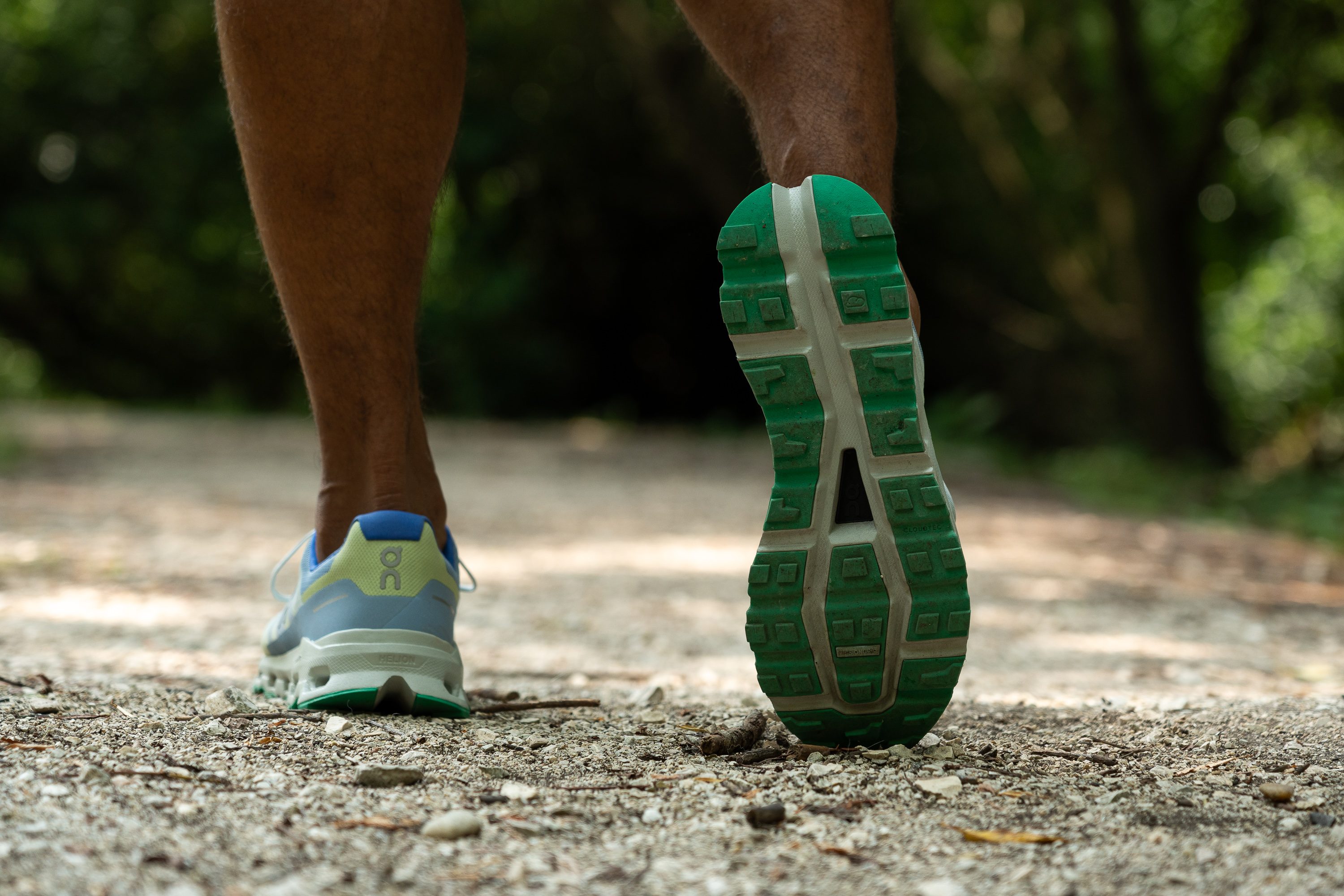
Lug depth
The Cloudvista's lugs are shorter than average, measuring only 2.5 mm according to our caliper. This low-profile lug configuration makes the Cloudvista feel less blocky on asphalt as traditional trail shoes, which makes us classify it as more of a hybrid shoe.

While it performed fine on roads and less technical terrain; the Cloudvista's subtle lug configuration let us down on more challenging trails. When confronted with rugged or muddy terrain, we just didn’t have enough grip to feel surefooted at moderate to high speeds.
We therefore recommend sticking to milder trails or well curated park trails with the Cloudvista. For a shoe that will brave the elements over even the wildest of terrains, we suggest checking out the Brooks Cascadia 16.
| Cloudvista | 2.5 mm |
| Average | 3.5 mm |
Flexibility / Stiffness
Despite the speedboard, the Cloudvista is a flexible shoe. Requiring only 21N of force to bend the shoe to 90-degrees makes it significantly less stiff than our current lab average for trail shoes.
This means that, on our test runs, the Cloudvista felt comfy and natural underfoot, with the shoe easily taking the shape of our foot during our stride. Even after long miles we didn’t have to contend with hotspots or feet that felt beaten up.
Pronating runners, however, will benefit from a stiffer shoe with added stability features like the Salomon XA Pro 3D V8.
This test follows an older methodology, which is why you don't see recently tested shoes in the chart. Results from different methodologies can not be compared.
| Cloudvista | 21.8N |
| Average | 27.1N |
Stiffness in cold (%)
Repeating our flexibility test after leaving the Cloudvista in the freezer for twenty minutes yielded a result of only 32.9N of force required to bend it 90-degrees. This result is much lower than our current lab average, and means that the Cloudvista remains plenty flexible in the cold.
While the shoe does stiffen up more than the average shoe, becoming 50.6% more rigid in the cold, the Cloudvista remains almost as flexible as most shoes at room temperature!
| Cloudvista | 51% |
| Average | 32% |
Weight
The Cloudvista tips the scale at 10.05 Oz (285g). While this makes it only a little lighter than our current lab average for trail shoes, we found that the Cloudvista feels lighter underfoot than the scale suggests.
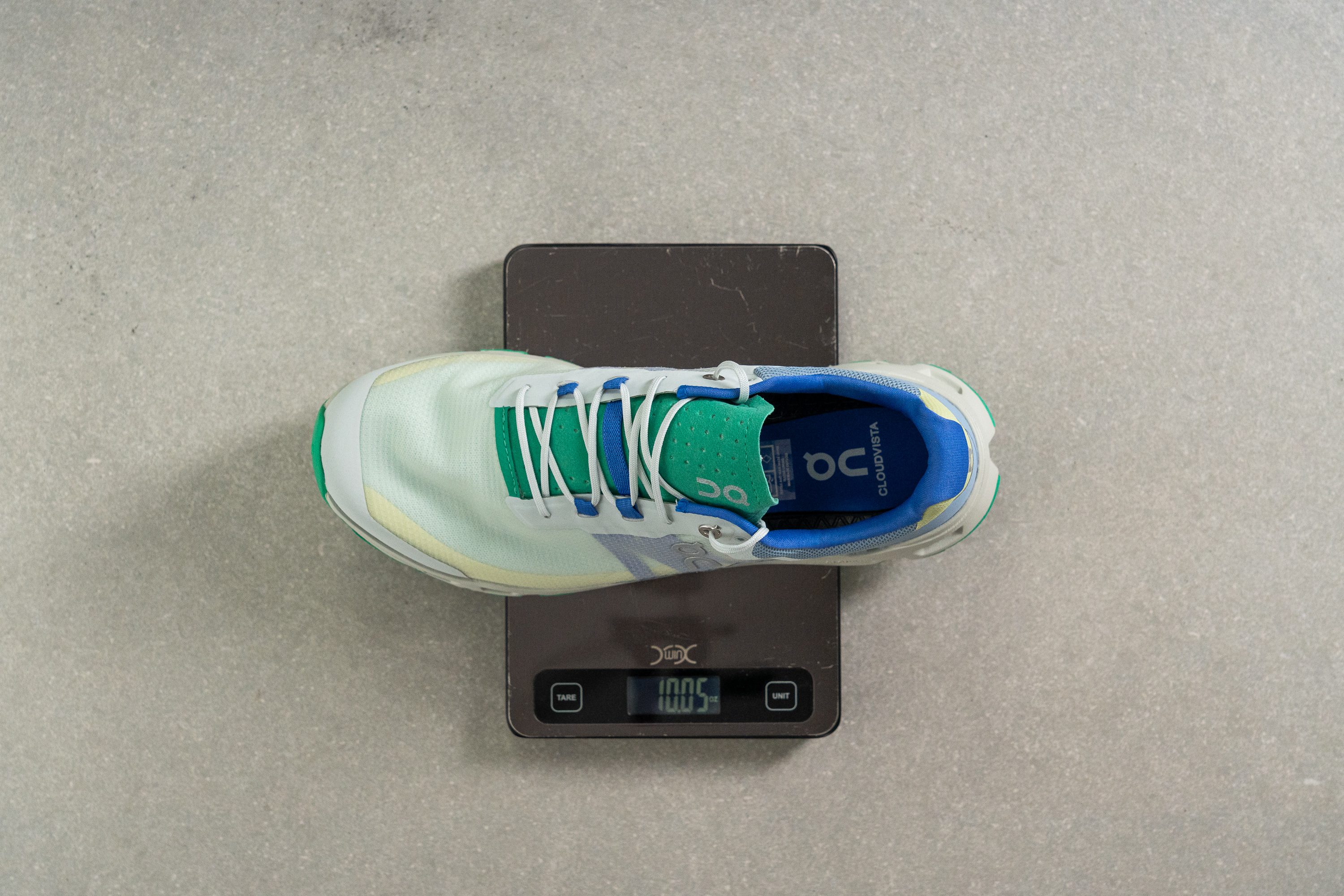
| Cloudvista | 10.1 oz (285g) |
| Average | 10.2 oz (289g) |
Breathability
Upon first glance the Cloudvista may not look very well ventilated, but putting it through our smoke test reveals that it’s actually an extremely breathable shoe. Just look at how quickly and easily the smoke escapes through the mesh upper and the perforated tongue.
Shining a light through a cross section of the upper further reveals just how delicate the polyester mesh is; appearing almost see-through apart from the areas covered by the TPU mudguards.
Our closeup shot of the Cloudvista’s toebox shows how heat has plenty of places to dissipate through its upper’s delicate, crystalline weave. All these factors lead us to score the Cloudvista a perfect 5 out of 5 for breathability.
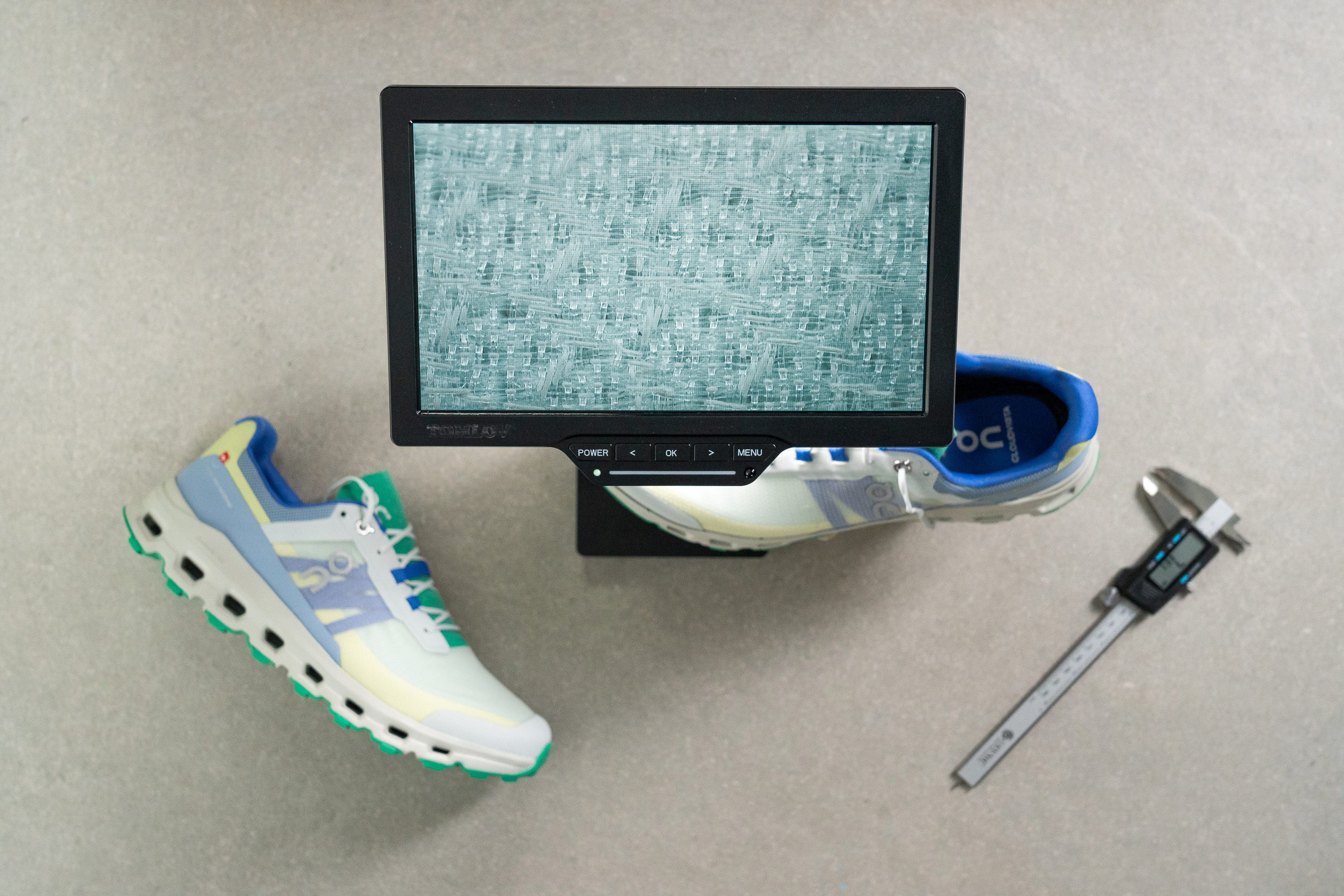
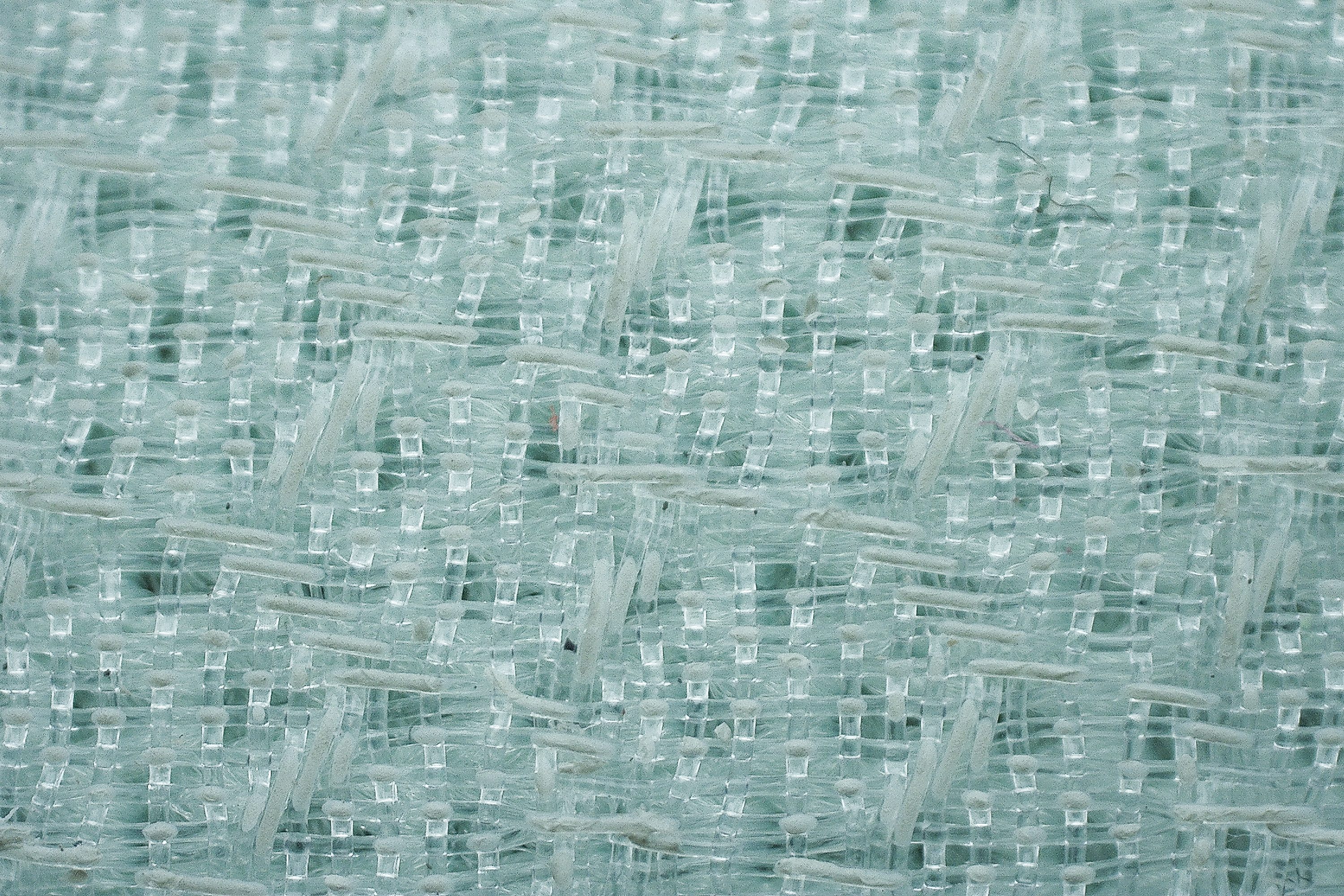
| Cloudvista | 5 |
| Average | 3.2 |
Stability
Lateral stability test
The Cloudvista felt pretty stable underfoot when we shifted our weight from side to side on flat ground. Taking it out on more technical terrain is where we experienced the occasional ankle roll when landing on larger rocks or uneven surfaces.
Torsional rigidity
The Cloudvista features a semi-rigid speedboard between the midsole and the outsole which gives the shoe some added stiffness. However, as you can see from the video, we were still able to twist and contort it with some level of ease; giving the Cloudvista a score of 3 out of 5 on our subjective scale.
This means that we felt the shoe adapt to our foot during our test runs, with the speedboard definitely contributing to the Cloudvista’s responsive and poppy feeling underfoot.
| Cloudvista | 3 |
| Average | 3.6 |
Heel counter stiffness
The heel counter is quite soft, as you can see from how little resistance it offers when we push and squeeze it. We gave it a score of 2 out of 5 on our subjective scale.
The shape of the heel cup and the level of padding in the collar meant that we were still able to lock our feet down comfortably; with the shoe gently holding our foot in place rather than pinching down on the Achilles.
| Cloudvista | 2 |
| Average | 3 |
Midsole width - forefoot
At 107 mm according to our caliper measurement, the Cloudvista’s midsole is narrow at the forefoot for a trail shoe. This gives us a little less platform to land on than the average shoe and contributes to the shoe’s unstable feeling on uneven terrains.
Forefoot striking runners should consider the Hoka Speedgoat 5 as it boasts a wider platform at the forefoot to ensure more steady landings.

| Cloudvista | 107.0 mm |
| Average | 112.8 mm |
Midsole width - heel
At the heel meanwhile, the Cloudvista falls right within the average range at 88.5 mm. This. along with the shoe’s high drop make it more beneficial for heel-striking runners as it will provide them with good stability and support.
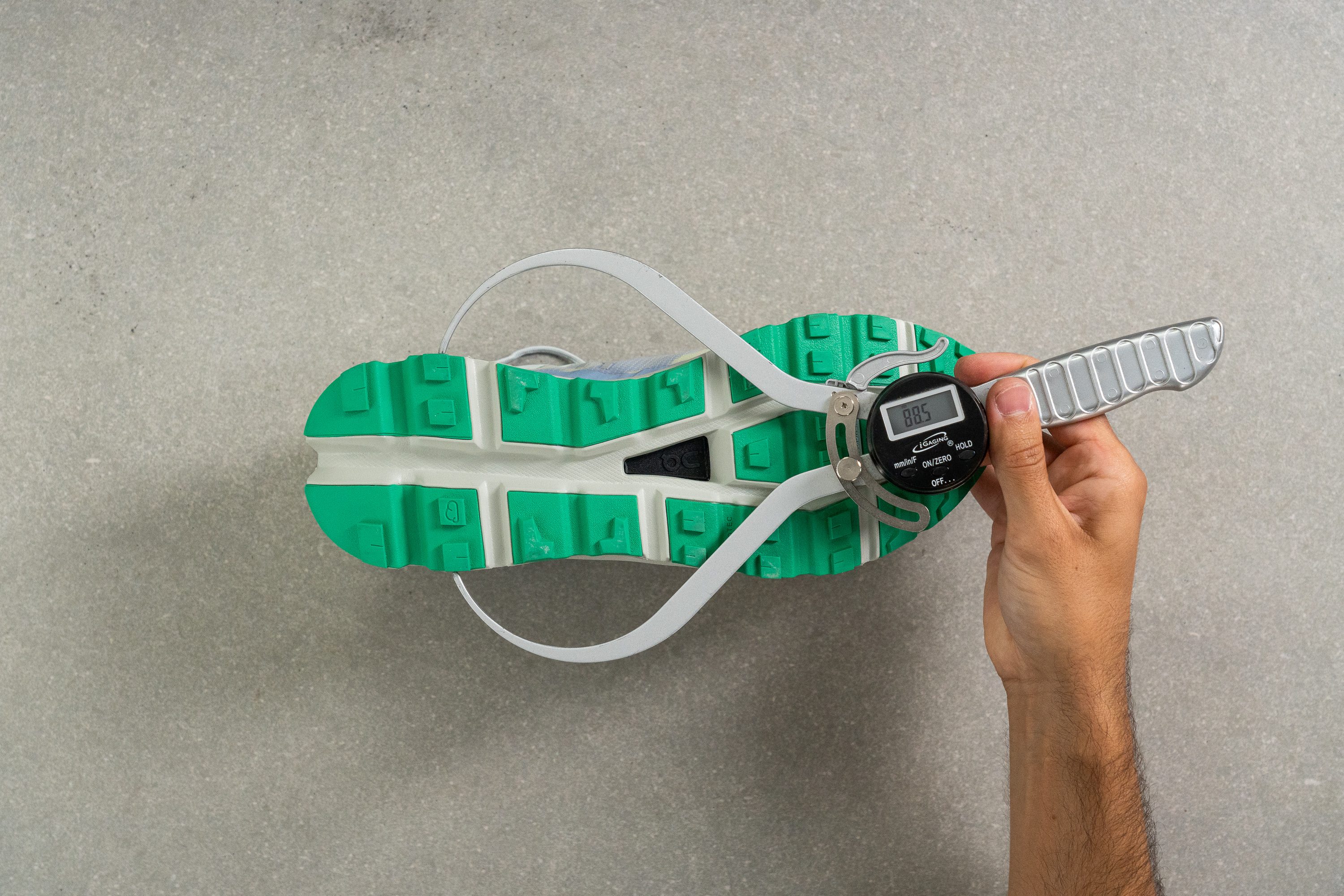
| Cloudvista | 88.5 mm |
| Average | 89.9 mm |
Durability
Toebox durability
We used a Dremel to simulate extreme wear and tear on the Cloudvista’s toebox. The tool easily tore through the fine material and left a gaping hole after the four second test. We therefore give the toebox a durability score of 1 out of 5 as one unlucky snag on a low-hanging branch can easily compromise the Cloudvista’s upper.
This should be okay for park runners; but for those who brave the more wild and unkempt trails we recommend looking at the Nike Terra Kiger 9, which boasts more protective features in the toebox area.
| Cloudvista | 1 |
| Average | 3.1 |
Heel padding durability
The heel collar suffered a similar fate at the hands of our Dremel. After four seconds of applying a force of 3.2N at 10K RPM we had absolutely minced through the padding with no resistance. Thus, we give the Cloudvista's heel padding a score of 1 out of 5 when it comes to durability.
We therefore don’t recommend going for runs sockless in the Cloudvista, as the friction caused by excessive heel rubbing will definitely wear down the padding at the rear, potentially compromising the shoe’s comfort and lockdown
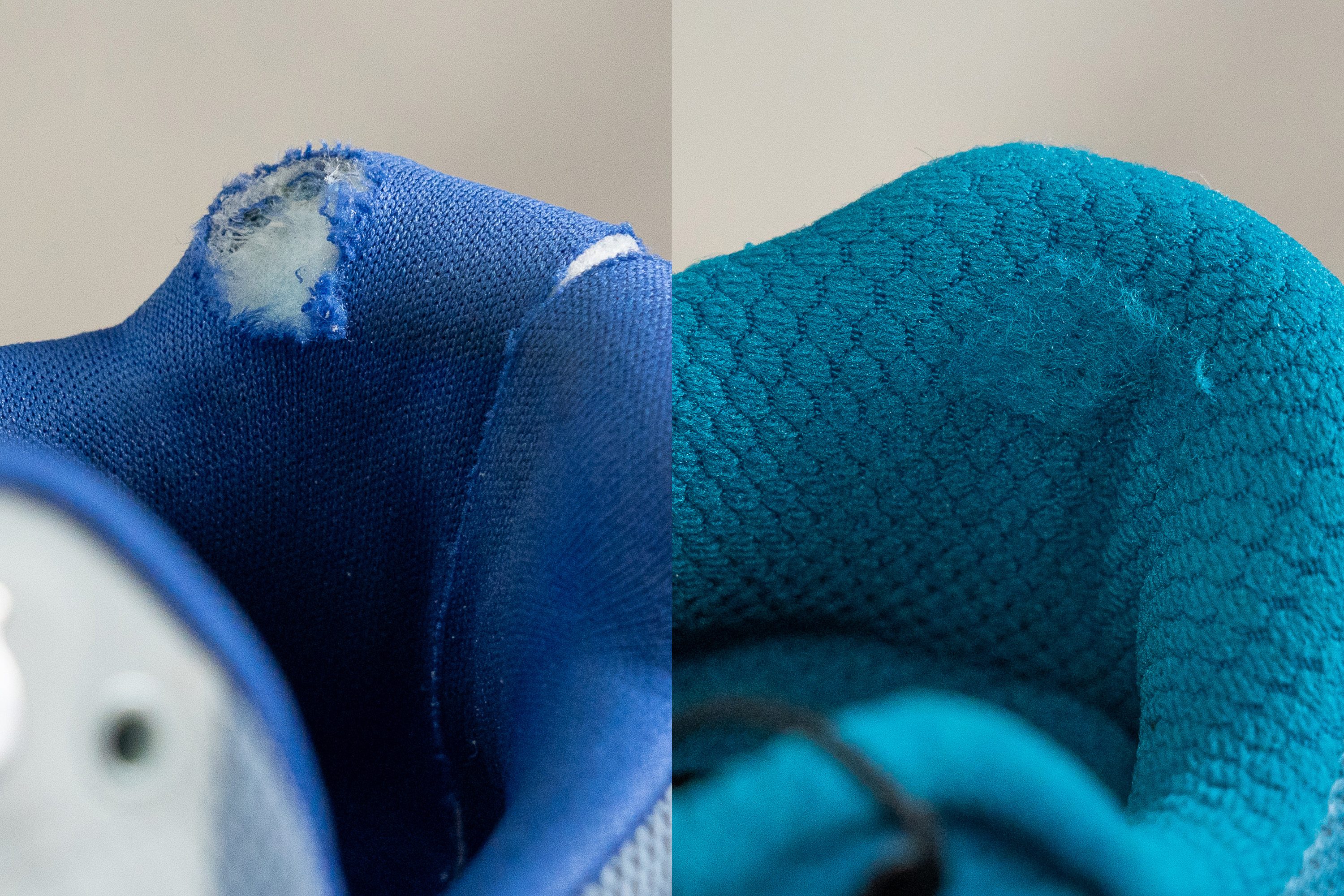
For a shoe with more durability around the heel, have a look at the Salomon Ultra Glide 2 pictured on the right.
| Cloudvista | 1 |
| Average | 3 |
Outsole hardness
Using our durometer to measure the hardness of the Missiongrip rubber that makes up the Cloudvista’s outsole and lugs reveals a higher than average reading of 92.3 HC.
While a higher reading does factor into better outsole durability, we find that it’s a little too hard to really bite into harder surfaces, especially when wet. We wouldn’t recommend taking the Cloudvista out on the road during or after heavy rain.
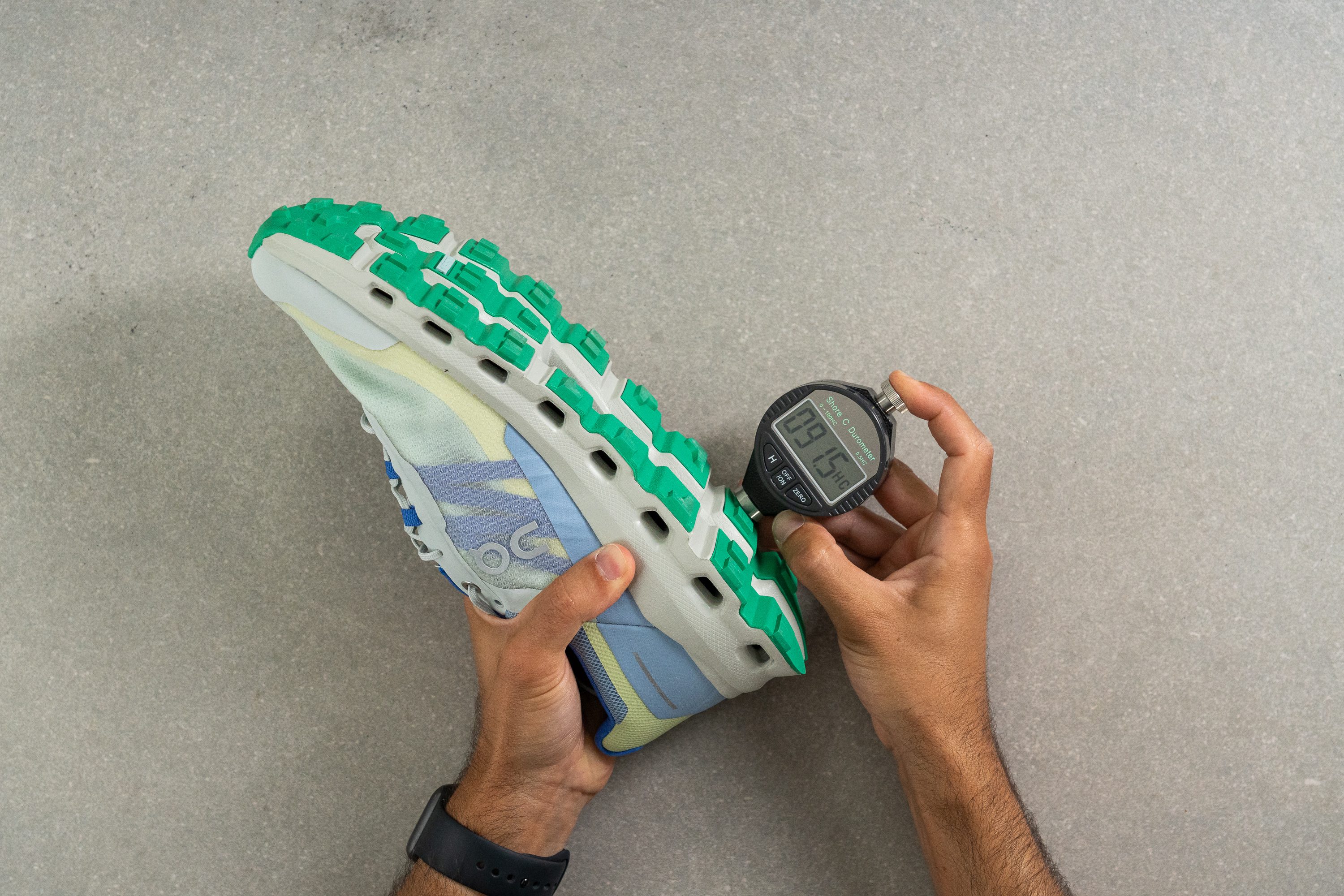
| Cloudvista | 92.3 HC |
| Average | 85.8 HC |
Outsole durability
Our Dremel didn’t have nearly the same impact on the Cloudvista’s outsole as on the shoe’s upper. Applying the grinding element to one of the lugs with force of 3.2N for four seconds only lopped off 0.72 mm. We therefore conclude that even well after 500-miles there should still be plenty of surviving rubber on the bottom of the Cloudvista.
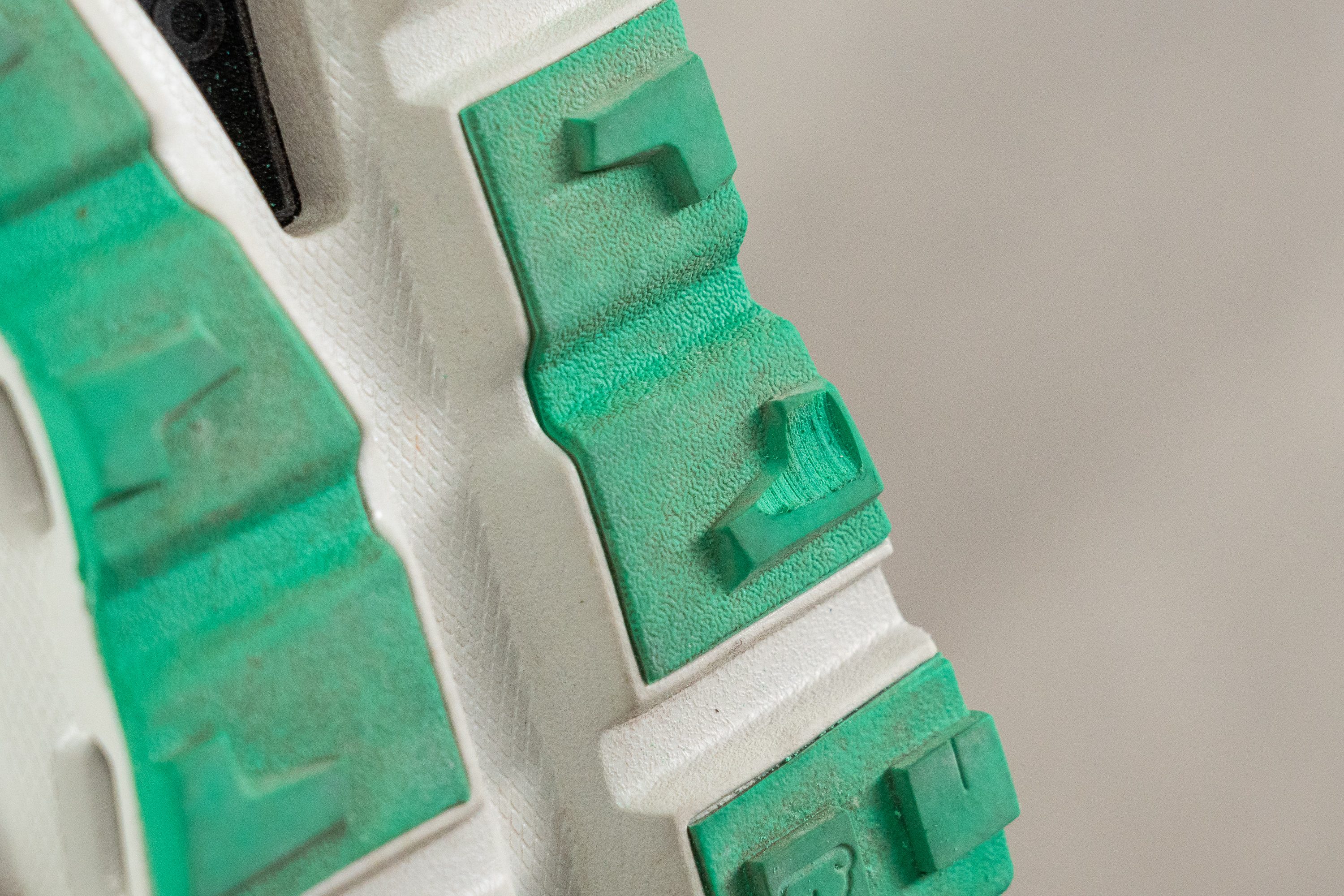
| Cloudvista | 0.7 mm |
| Average | 0.9 mm |
Outsole thickness
The Cloudvista’s outsole is quite low-key for a trail shoe. The midsole sits on only 2.1 mm of rubber according to our caliper, which is slightly shorter than our lab average.
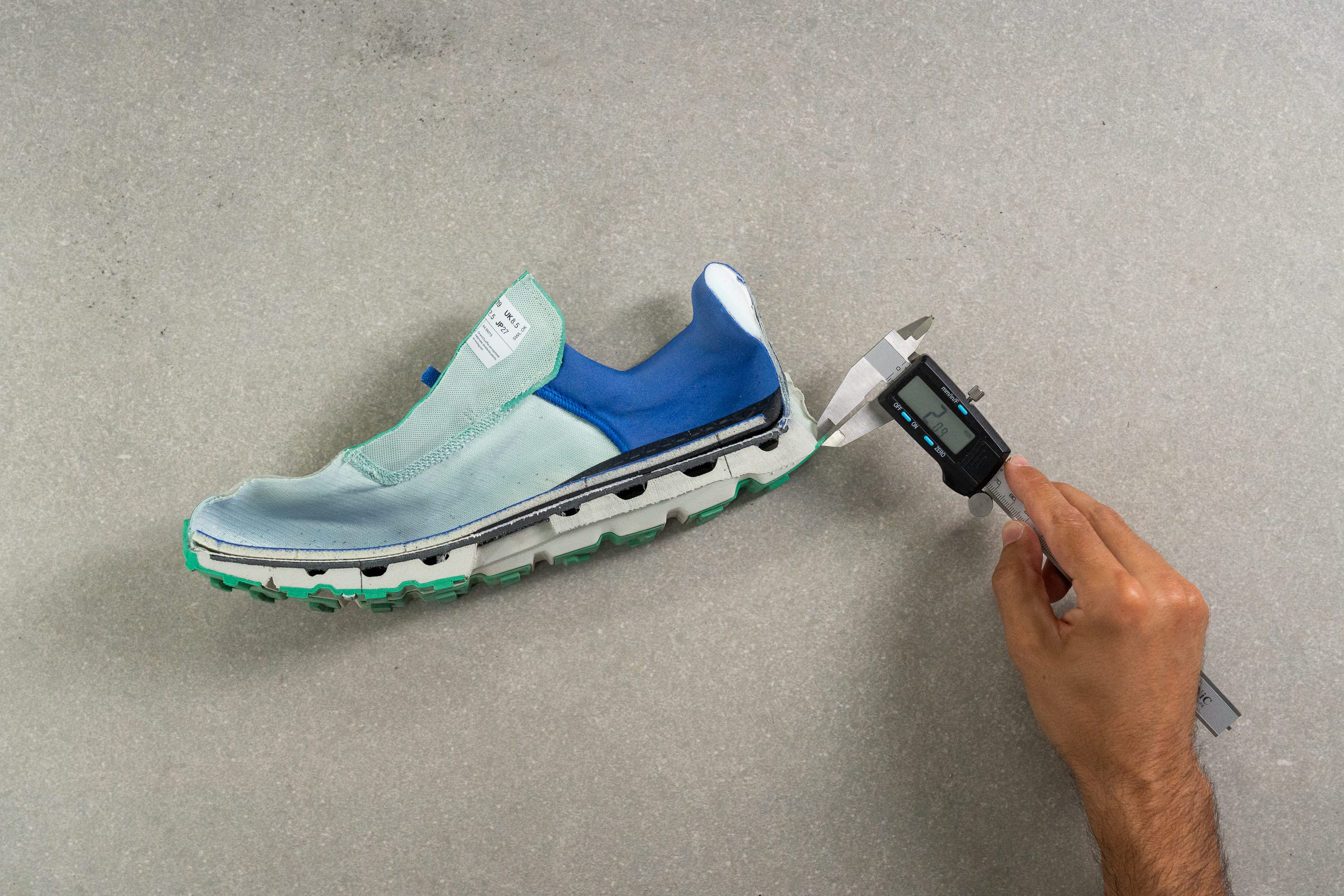
Minimizing the amount of rubber in the outsole contributes to the Cloudivsta’s lightweight nature.
| Cloudvista | 2.1 mm |
| Average | 2.2 mm |
Misc
Insole thickness
What the Cloudvista's tongue lacks in cushioning the insole more than makes up for. At 5.8 mm according to our caliper, the insole is among the plushest we’ve measured in the lab.
This gives us an extra-soft landing surface inside the shoe that’s forgiving on the foot even when traversing difficult terrain.
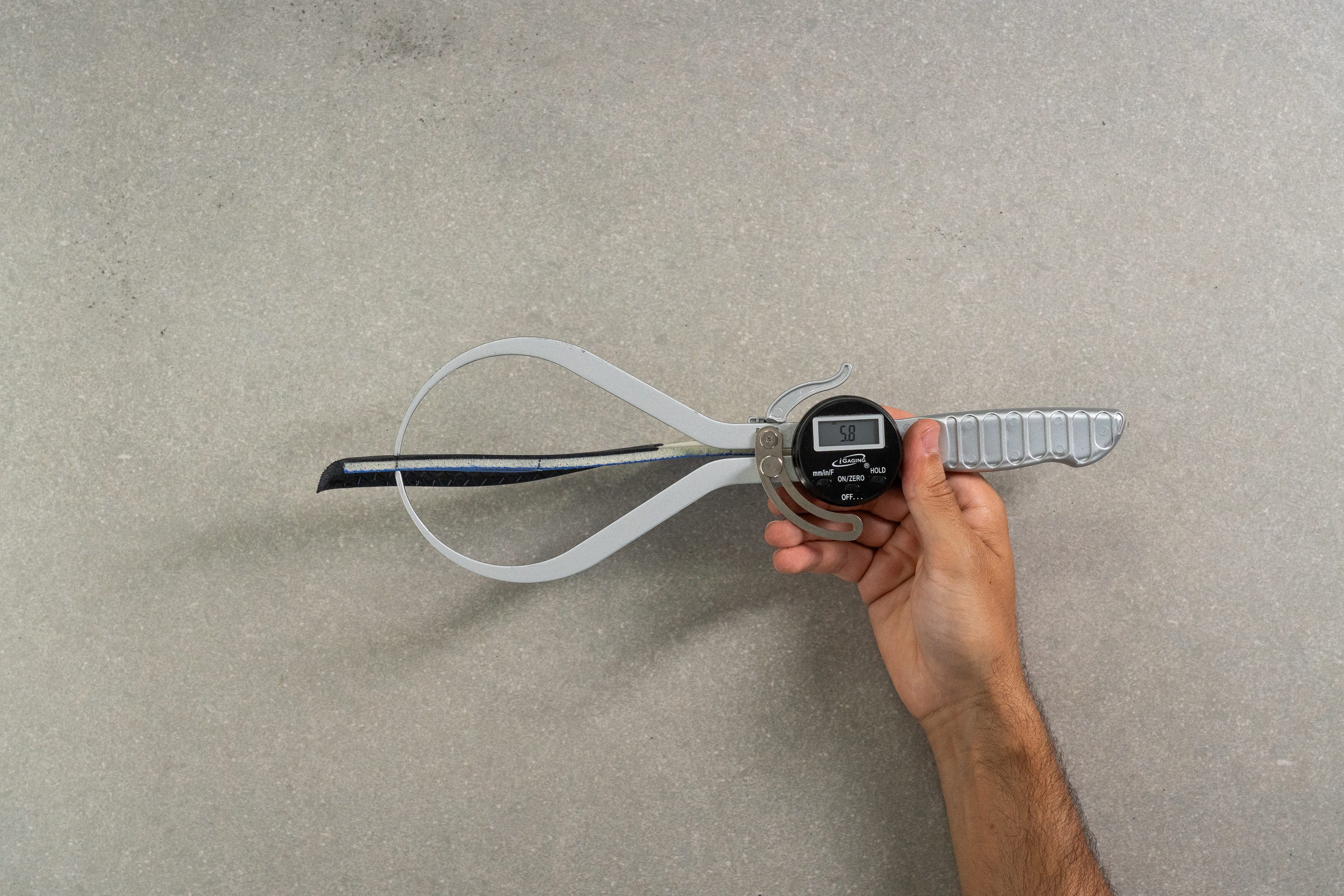
| Cloudvista | 5.8 mm |
| Average | 4.7 mm |
Removable insole
The Cloudvista’s plush insole is removable, so runners in need of orthotics can replace it if necessary.
| Cloudvista | Yes |
Midsole softness in cold (%)
To simulate exposure to cold weather, we after letting the Cloudvista chill with our ice cream in the freezer for twenty minutes. We then pressed the durometer against the midsole again and got a reading of 36.8 HA; making the Cloudvista’s midsole only slightly stiffer than the average shoe under similar conditions.
While we expect a shoe to get more stiff in cold weather; a 56.4% difference in the midsole softness between warm and cold means the Cloudvista stiffens up more than the average shoe. This makes it feel less consistent underfoot than other shoes depending on the weather.
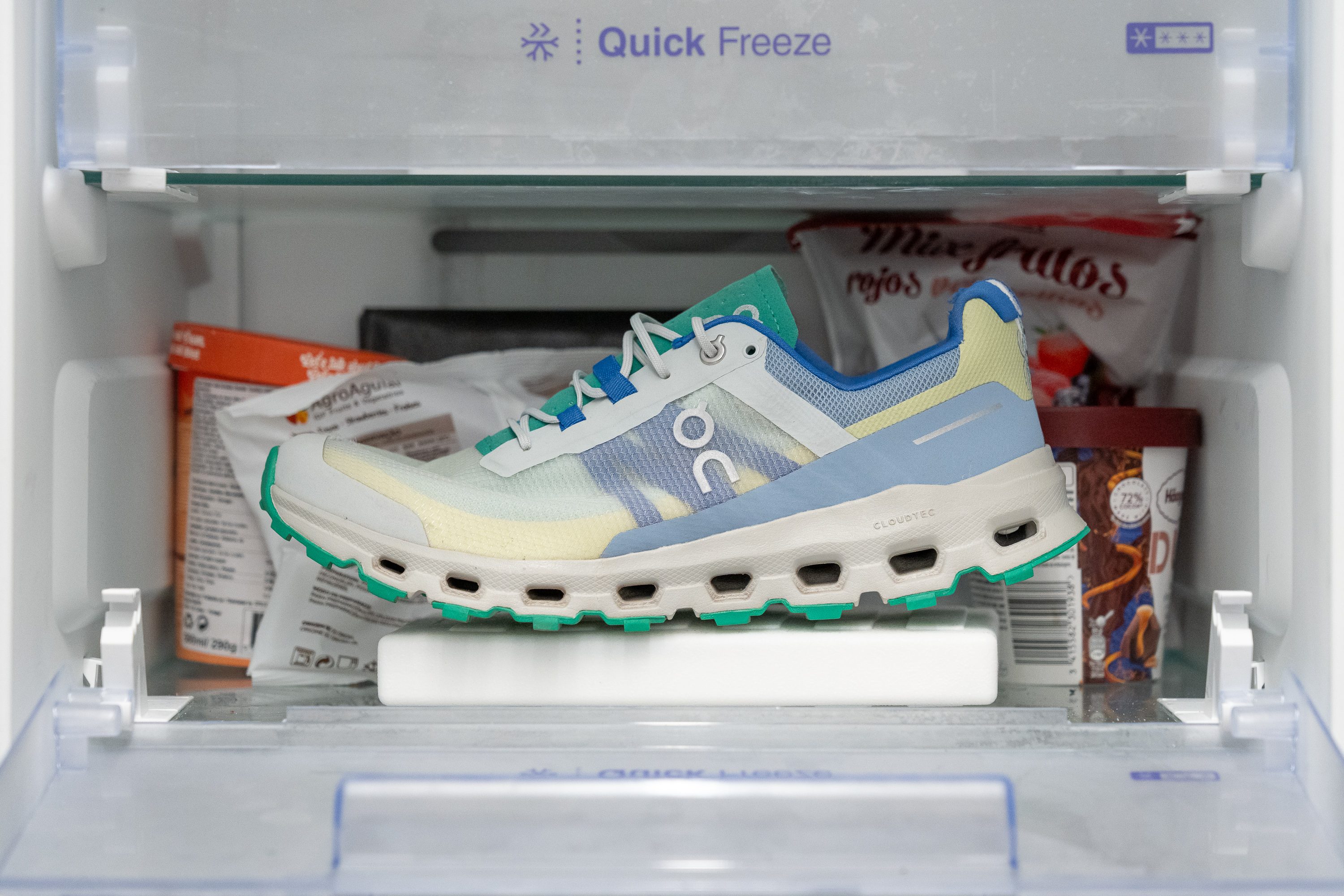
| Cloudvista | 56% |
| Average | 26% |
Reflective elements
We recommend using high-visibility clothing when running with the Cloudvista at night. The only reflective elements that can be found is in the logo on the outside of the shoe which, albeit an elegant design, does little for being seen in the dark.
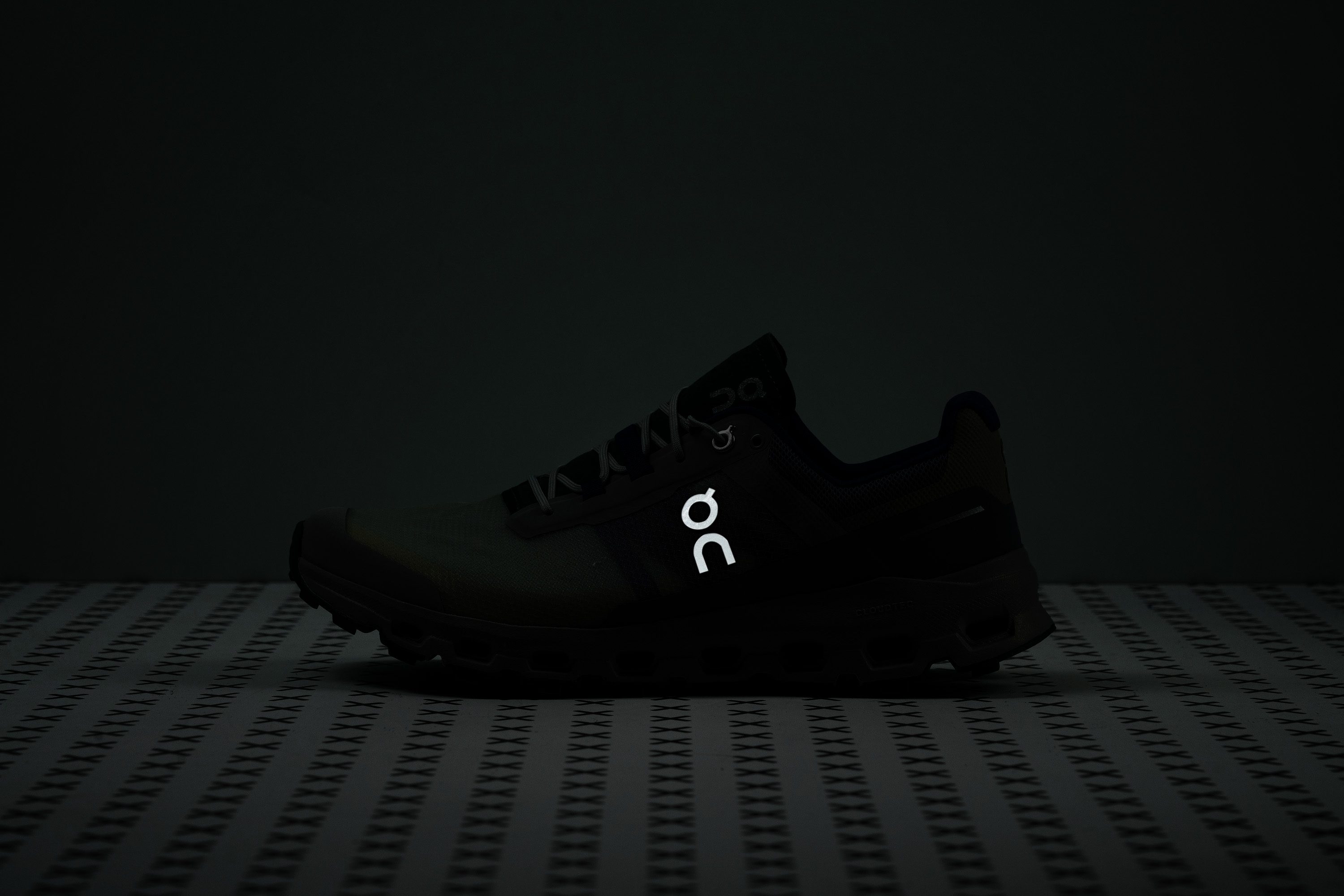
| Cloudvista | Yes |
Tongue padding
The Cloudvista sports a perforated micro-fiber tongue that is paper thin. At 1.6 mm according to our caliper, it is substantially thinner than the average trail shoe, and a departure from On’s typically plush uppers. By skimping on padding in the tongue though, On manages to shave some weight off the Cloudvista.
We still found the Cloudvista to be extremely comfortable around the instep, and didn’t experience any lace bite once we’d secured the shoe.
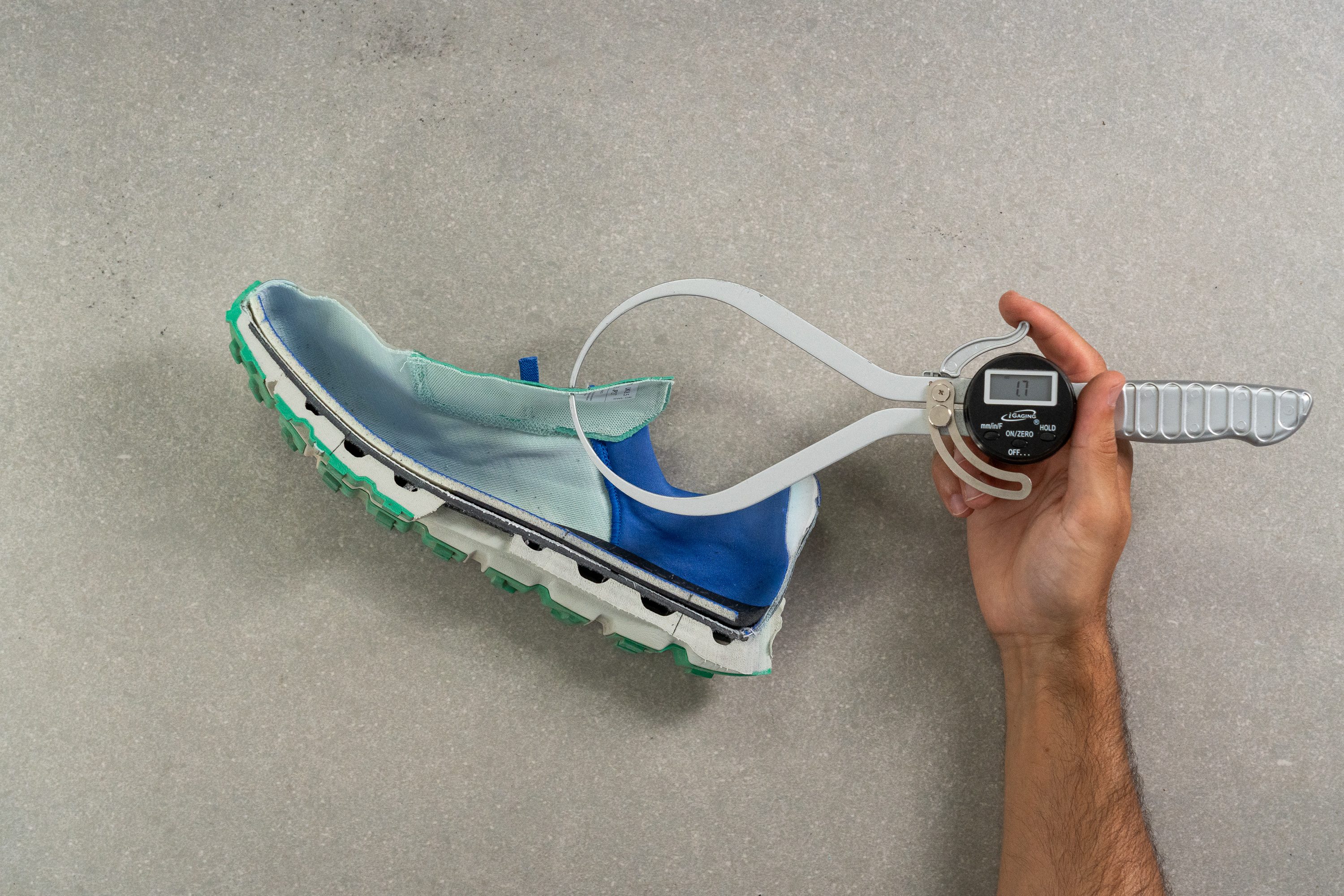
| Cloudvista | 1.7 mm |
| Average | 6.4 mm |
Tongue: gusset type
The Cloudvista’s tongue is fully gusseted on both sides which aids in providing a strong midfoot lockdown. This is typical for trail shoes as it prevents debris from entering the shoe.
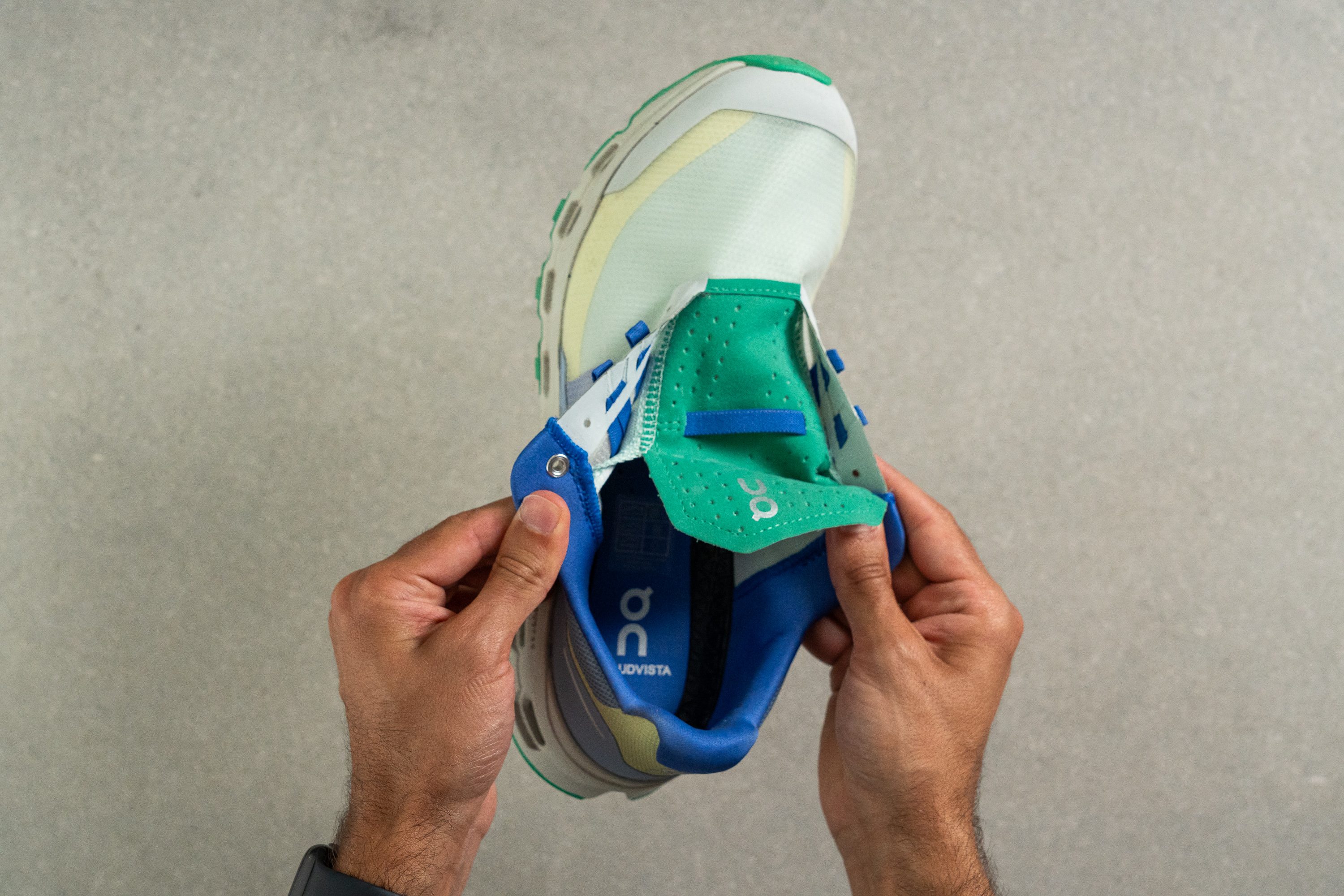
| Cloudvista | Both sides (full) |
Heel tab
The Cloudvista doesn’t feature any heel tab, but we didn’t have any trouble slipping our foot in and out of the shoe and its nicely shaped heel-cup.
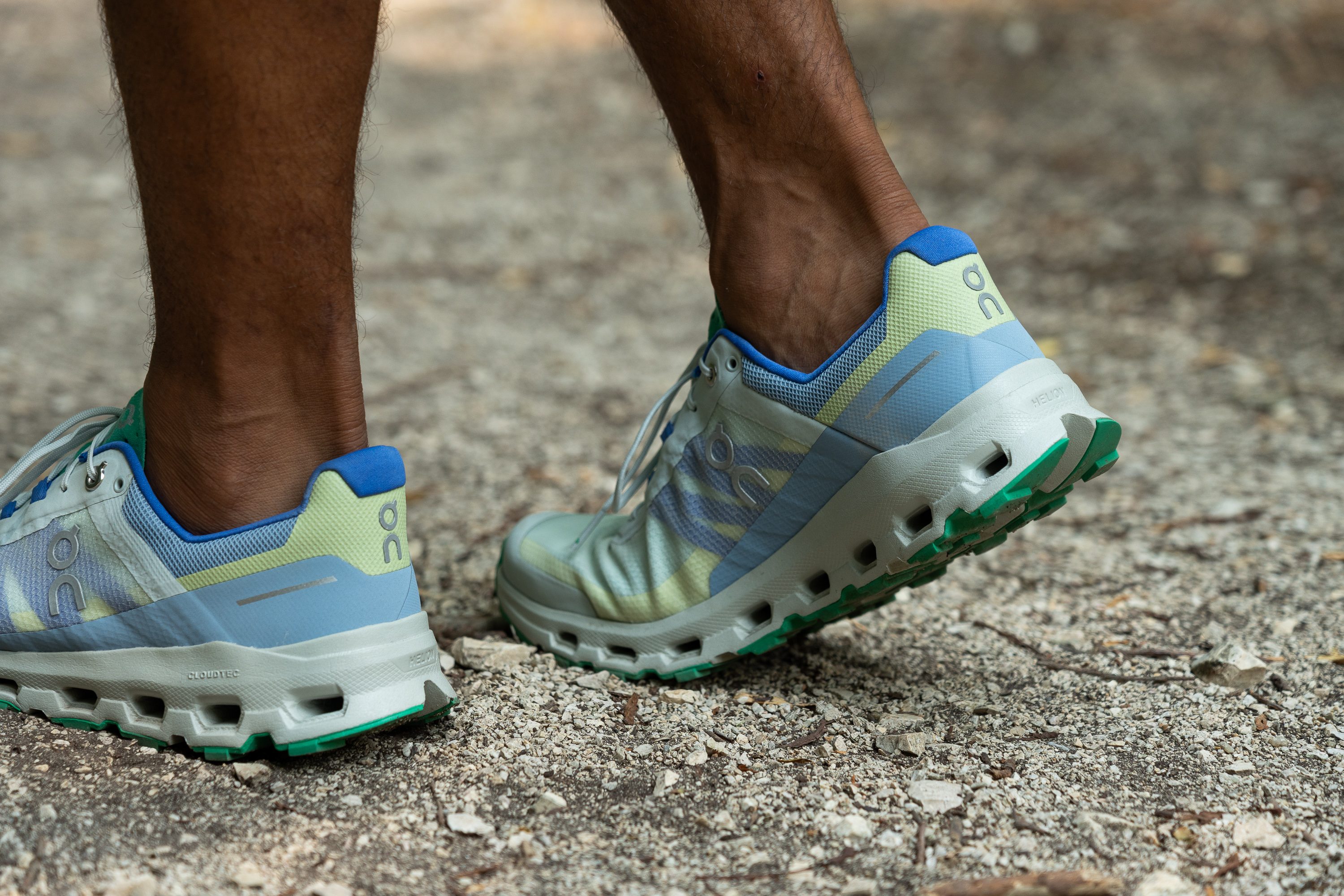
| Cloudvista | None |
Lace garage
The Cloudvista features a lace garage in the form of an elastic strap that runs across the tongue. This allows us to keep our laces tucked away; preventing them from bouncing around and getting snagged or untied on our runs.
